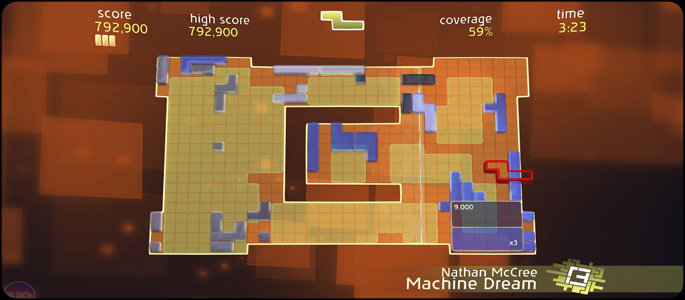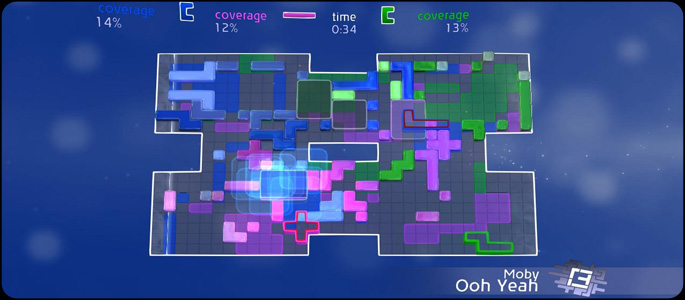
Welcome to one of the PSN’s most simple and relaxing games. Chime Super Deluxe is a revamped title originally released on the Xbox 360 last spring that combines the feeling of mixing and sampling over a pop infused beat with a classic game mechanic twist. Now, a year later, the music synth/block puzzle game comes to the PSN with heightened visuals, twice as many songs, and the most anticipated feature – a multiplayer mode featuring up to 4 local friends. There is plenty to explore, and music lovers will dig the catchy soundtrack, but fair warning: this game wasn’t made for everyone.
Jump into Chime, and you’ll see the gameplay is simple and takes no explanation if you’ve ever played a block-placing game. You’re in view of a large grid with different shaped blocks at your command. Players move individual shapes around, rotating and placing them on the grid in order to create square or rectangular ‘quads’ at least 3×3 in size. Once formed, quads will begin to fill up. By adding an additional side to a quad before it fills completely you can restart the filling process and achieve more points. Let it fill completely, however, and it becomes inactive and waits to be stamped into the grid by the beatline.
The beatline is where the depth and challenge of the game comes from, as it attempts to interweave the music and puzzle aspects into one seamless being. The beatline travels continuously from left to right across the grid in time with the music. As it passes over quads and fragments of blocks left over from creating a quad, music samples are triggered. The shape, size and position of each quad and fragment piece creates a different sample sound. Typically, when the beatline hits a quad, it triggers a larger sample sound, like a person singing or a musical instrument playing a lick. Fragments, on the other hand, trigger smaller sounds like drum hits, chimes or rhythmical pops and slaps. As the beatline travels over completed quads, they are permanently stamped into the grid, changing the color and adding more time to the clock. The objective then, is to fill the playing grid in color 100% in order to move on to the next stage.

As you can imagine, this is not actually that easy. Quads are not all perfect, and by the time you’re a minute into the match, you’ll find your board covered with leftover, unwanted blocks. Simultaneous to cueing sample sounds, the beatline drains these fragments of their ‘life’ and after enough passes, a fragment will die, rendering the entire grid fragment-less and dropping your score multiplier to 0. You’re caught in a balancing act between keeping the board nice and tidy, while you try to expand and conquer as much as you can, as fast as you can. This gameplay is simple and surprisingly addictive as you’ll find yourself replaying matches continually trying to get further and further, despite the inevitable fate of each level: an empty timebar and an option to try again.
This simplicity, however, is what ultimately hurts Chime. The puzzle gameplay is entertaining and requires fast thinking, yet the interaction with the music within the game is insubstantial and gimmicky. Uniqueness and creativity are irrelevant factors rather than having been tied in with the overall game design. There is no customizable options, and while each song really does come alive when you’ve covered the board with pieces and fragments, you won’t ever really feel in control. The potential is laid out for deeper player control that rewards one for the use of the beatline and sampling, but instead, playing and beating this game with your TV muted not only goes completely unhampered, but also results in zero consequences. Mind you, levels would not be nearly as interesting, but the success of your gameplay is entirely puzzle based.
But what the game lacks in this creative control it attempts to redeem itself with the multiplayer mode. You’ll understand immediately why this was the most clamored for addition in the event of a rerelease; it’s a lot of fun. Get another man on board for co-op, and suddenly creating giant quads, and filling the screen to completion becomes not only feasible, but incredibly challenging and engaging. Moreover, versus matches pin you against your friends as you all compete to obtain the largest percentage of the board. With a few other people playing, the grid can get tight and competitive, especially with the ability to steal quads from each other. The fun is short-lived and good for small sessions, and without an online mode, you’d better have some puzzle loving friends if you want to get the most out of it.

Music for the title ranges from a dance techno pop style by Sabrepulse, to slower ballads like For Silence by Paul Hartnoll to even a full-bodied strings piece, Sympathy by Joe Hogan. With only 10 tracks though, you can quickly play through the entire set list in a little under an hour. While this is certainly disheartening, maybe the feeling stems from being trained over the past generation that music titles should spoil you with their vast array of music selections. After all, it can be understood that you will never hear the same song in a level of Chime with the level of variation it provides. Nevertheless, we wouldn’t doubt future DLC tracks to give Chime some more life.
Chime Super Deluxe is the type of game where you know what you’re going to get. It’s a puzzle game that had the ability to set itself apart from the genre with the addition of music elements, but fell prey to the ease of taking the traditional route. However, this traditional route is tried and true, and known to deliver. If you have hesitations, give the demo a go; it accurately portrays what to expect of the whole game.
PlayStation LifeStyle’s Final Score
+/- Multiplayer adds new dimension, but not online – Music, while cool, is not incorporated into gameplay |
 |
–




